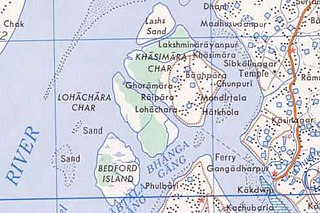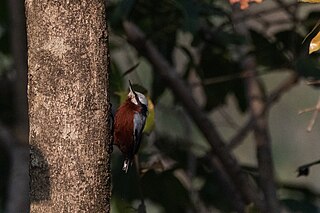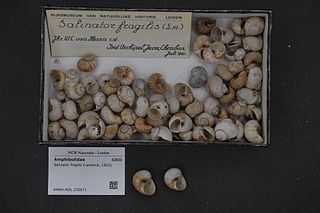Events in the year 1947 in India. It was a very eventful year as it became independent from the British crown, resulting in the split of India and Pakistan. Many people died during partition and India became a democracy.

The cotton pygmy goose or cotton teal is a small perching duck which breeds in Asia, Southeast Asia extending south and east to Queensland where they are sometimes called white-quilled pygmy goose. They are among the smallest waterfowl in the world and are found in small to large waterbodies with good aquatic vegetation. They are usually seen in pairs or larger groups of pairs, roosting and nesting on trees near water. They are strong fliers and are known to disperse widely, especially in winter. Their breeding season coincides with the rains.

The velvet-fronted nuthatch is a small passerine bird in the nuthatch family Sittidae found in southern Asia from Nepal, India, Sri Lanka and Bangladesh east to south China and Indonesia. Like other nuthatches, it feeds on insects in the bark of trees, foraging on the trunks and branches and their strongly clawed toes allow them to climb down tree trunks or move on the undersides of horizontal branches. They are found in forests with good tree cover and are often found along with other species in mixed-species foraging flocks. Adult males can be told apart by the black stripe that runs behind and above the eyes. They have a rapid chipping call note. They breed in tree cavities and holes, often created by woodpeckers or barbets.

The Sundarbans National Park is a national park in West Bengal, India, and core part of tiger reserve and biosphere reserve. It is part of the Sundarbans on the Ganges Delta and adjacent to the Sundarban Reserve Forest in Bangladesh. It is located to south-west of Bangladesh. The delta is densely covered by mangrove forests, and is one of the largest reserves for the Bengal tiger. It is also home to a variety of bird, reptile and invertebrate species, including the salt-water crocodile. The present Sundarban National Park was declared as the core area of Sundarban Tiger Reserve in 1973 and a wildlife sanctuary in 1977. On 4 May 1984 it was declared a national park. It is a UNESCO World Heritage Site inscribed in 1987, and it has been designated as a Ramsar site since 2019. It is considered as a World Network of Biosphere Reserve from 1989.

Sundarbans is a mangrove area in the delta formed by the confluence of the Ganges, Brahmaputra and Meghna Rivers in the Bay of Bengal. Spread across parts of India and Bangladesh, this forest is the largest mangrove forest in the world. It spans the area from the Baleswar River in Bangladesh's division of Khulna to the Hooghly River in India's state of West Bengal. It comprises closed and open mangrove forests, land used for agricultural purpose, mudflats and barren land, and is intersected by multiple tidal streams and channels. Sundarbans is home to the world's largest area of mangrove forests. Four protected areas in the Sundarbans are enlisted as UNESCO World Heritage Sites, viz. Sundarbans West (Bangladesh), Sundarbans South (Bangladesh), Sundarbans East (Bangladesh) and Sundarbans National Park (India).

The northern river terrapin is a species of riverine turtle native to Southeast Asia. It has been classified as Critically Endangered on the IUCN Red List and considered extinct in much of its former range; as of 2018, the population in the wild was estimated at 100 mature individuals.
Marichjhanpi is an island set in the mangrove forests of the Sundarbans in West Bengal, India. It is primarily known today for the Marichjhapi massacre in 1979 when the newly elected Communist Party of India (Marxist) government of West Bengal evicted several post-partition Dalit refugees who were living in the reserved forest. The clash between armed residents and the police resulted in about 10,000 deaths. Although the exact death count is unknown, researchers believe that several collateral deaths took place from violent clashes, alleged police brutality, and disease.

Lohachara Island was an islet which was permanently flooded in the 1980s. It was located in the Hooghly River as part of the Sundarban delta in the Sundarban National Park, located near the Indian state of West Bengal. The definite disappearance of the island was reported by Indian researchers in December 2006, which led to international press coverage. No specific study was ever done to prove that the island was permanently inundated because of sea level rise.

The Indian nuthatch is a species of bird in the family Sittidae. It is found in Bangladesh, India and Nepal.

Eleutherocaulis haroldi, known as Purcell's hunter slug or the caterpillar slug, is a species of tropical land slug in the family Veronicellidae, the leatherleaf slugs. It was first formally named Laevicaulis haroldi in 1980.
Basanti is a census town and a gram panchayat within the jurisdiction of the Basanti police station in the Basanti CD block in the Canning subdivision of the South 24 Parganas district in the Indian state of West Bengal.

Salinator fragilis is a species of small, air-breathing land snail with an operculum, a pulmonate gastropod mollusc in the family Amphibolidae. The species is sometimes referred to as the fragile air breather. It was originally described as being in the genus Ampullaria, but was split off into the genus Salinator in 1900 by Charles Hedley.
Thakuran River is a tidal estuarine river that forms a wide estuary in and around the Sundarbans in South 24 Parganas district in the Indian state of West Bengal.

Sundarbans West Wildlife Sanctuary is a UNESCO World Heritage Site and animal sanctuary in Bangladesh. The area of the reserve covers 715 km2. It is part of the larger Sundarbans region, one of the largest mangroveforests in the world. It is formed at the unified delta of the Ganges, Brahmaputra and Meghna rivers on the Bay of Bengal. The total area of the entire Sundarbans is about one million ha, 60% of which is found in Bangladesh, with the remainder 40% in India. The region is divided by the Raimangal River. Within the Bangladeshi area of Sundarbans, there are three wildlife sanctuaries: Sundarbans East, Sundarbans South, and Sundarbans West.
Three species of crocodilian are present in India. The mugger crocodile is found in lakes and rivers throughout the country. The saltwater crocodile is found along the eastern coast of the country and the Nicobar and Andaman Islands. The gharial is found in river areas, though is greatly reduced from its previous range. In the pre-historic period, seven species resided in India.
Tushar Kanjilal was an Indian social worker, political activist, environmentalist, writer and headmaster of Rangabelia High School. He was the founder of a non governmental organization, which merged with the Tagore Society for Rural Development, a social organization working for the upliftment of the rural people in Sunderbans region, in the Indian state of West Bengal.
Gobardhanpur is a village within the jurisdiction of the Patharpratima police station in the Patharpratima CD block in the Kakdwip subdivision of the South 24 Parganas district in the Indian state of West Bengal.

Merope angulata is a species of flowering plant in the family Rutaceae. It is a tree that ranges from northeastern India through Bangladesh, Myanmar, the Andaman and Nicobar islands, Peninsular Malaysia, Borneo, Java, Sulawesi, the Philippines, and Maluku Islands to New Guinea. It is the sole species in genus Merope.
Lycosa shillongensis is a species of spiders of the genus Lycosa native to India In India this spider is reported from Manipur, Meghalaya and West Bengal.










